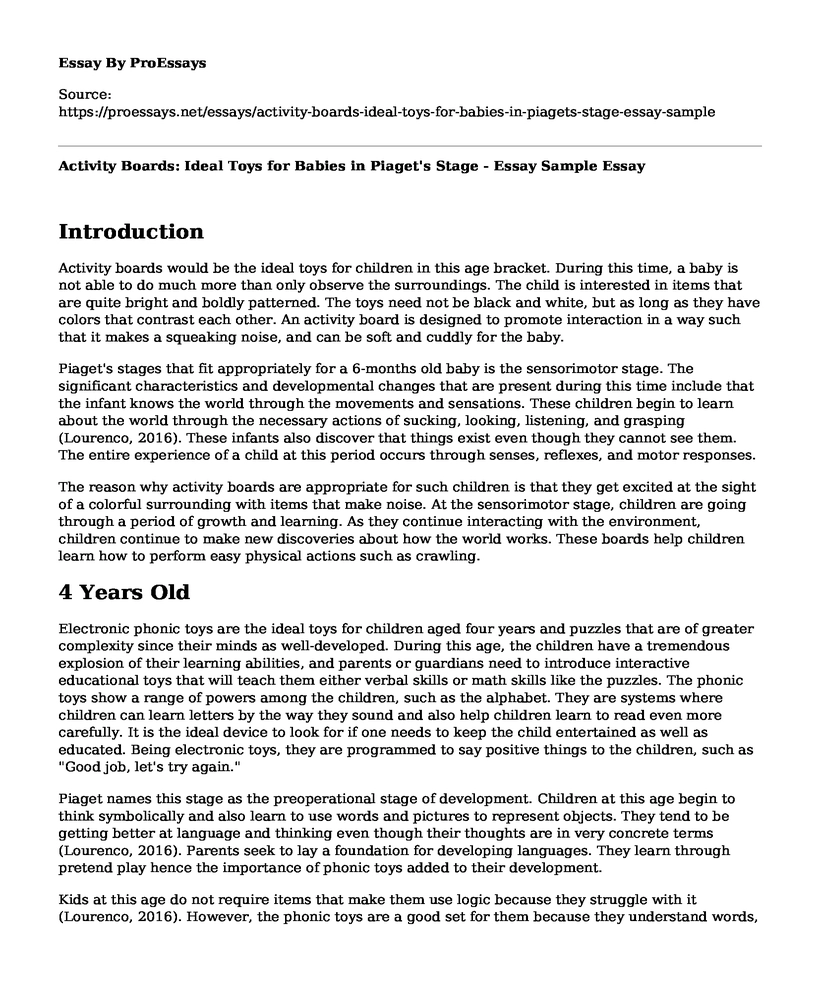Introduction
Activity boards would be the ideal toys for children in this age bracket. During this time, a baby is not able to do much more than only observe the surroundings. The child is interested in items that are quite bright and boldly patterned. The toys need not be black and white, but as long as they have colors that contrast each other. An activity board is designed to promote interaction in a way such that it makes a squeaking noise, and can be soft and cuddly for the baby.
Piaget's stages that fit appropriately for a 6-months old baby is the sensorimotor stage. The significant characteristics and developmental changes that are present during this time include that the infant knows the world through the movements and sensations. These children begin to learn about the world through the necessary actions of sucking, looking, listening, and grasping (Lourenco, 2016). These infants also discover that things exist even though they cannot see them. The entire experience of a child at this period occurs through senses, reflexes, and motor responses.
The reason why activity boards are appropriate for such children is that they get excited at the sight of a colorful surrounding with items that make noise. At the sensorimotor stage, children are going through a period of growth and learning. As they continue interacting with the environment, children continue to make new discoveries about how the world works. These boards help children learn how to perform easy physical actions such as crawling.
4 Years Old
Electronic phonic toys are the ideal toys for children aged four years and puzzles that are of greater complexity since their minds as well-developed. During this age, the children have a tremendous explosion of their learning abilities, and parents or guardians need to introduce interactive educational toys that will teach them either verbal skills or math skills like the puzzles. The phonic toys show a range of powers among the children, such as the alphabet. They are systems where children can learn letters by the way they sound and also help children learn to read even more carefully. It is the ideal device to look for if one needs to keep the child entertained as well as educated. Being electronic toys, they are programmed to say positive things to the children, such as "Good job, let's try again."
Piaget names this stage as the preoperational stage of development. Children at this age begin to think symbolically and also learn to use words and pictures to represent objects. They tend to be getting better at language and thinking even though their thoughts are in very concrete terms (Lourenco, 2016). Parents seek to lay a foundation for developing languages. They learn through pretend play hence the importance of phonic toys added to their development.
Kids at this age do not require items that make them use logic because they struggle with it (Lourenco, 2016). However, the phonic toys are a good set for them because they understand words, and they can interact with them. They prefer systems that are not fully developed and those that do every work for them. The reason why phonic toys would be appropriate is because they are educative and engage the minds of the children alongside being fun for them.
8 Years Old
The ideal toy for an 8-year old is board games such as scrabble or monopoly. At this age, the kids tend to enjoy outdoor sports like riding bicycles. They also acquire interests, abilities, and hobbies that are like those of adults and may also display the passion of becoming a collector. Scrabble is the best way to push oneself to expand their vocabulary and have fun with it. The wonders of scrabble can be proclaimed through the importance of enhancing spelling as it boosts how children use such words in their communication. 8-year olds are seeking social benefits like spending quality time with family and friends. Scrabble also fosters competitiveness and confidence among the players, and winners can celebrate victory while the rest try to be good at it hence expanding each individual's repertoire.
Piaget records this particular stage as the concrete operational stage of development. At this age, children are thinking logically about real events, and they are beginning to understand the intensity of conversations and what they let into their minds (Lourenco, 2016). Their thinking is more logical and organized. They reason through conversations and tend to consider how other people may respond to their actions. As such, scrabble is an excellent toy for these children to use and grow intellectually. It is a fun game that kids will definitely love now that they want to engage their minds in more productive activities. The childish plays are gone, and they begin to understand that the thoughts they have are quite unique for them and those other people don't necessarily share in their opinions.
Reference
Lourenco, O. M. (2016). Developmental stages, Piagetian stages in particular: A critical review. New Ideas in Psychology, 40, 123-137. Retrieved from https://www.researchgate.net/profile/Orlando_Lourenco/publication/283771814_Developmental_stages_Piagetian_stages_in_particular_A_critical_review/links/5a05f7730f7e9b682299017d/Developmental-stages-Piagetian-stages-in-particular-A-critical-review.pdf
Cite this page
Activity Boards: Ideal Toys for Babies in Piaget's Stage - Essay Sample. (2023, May 06). Retrieved from https://proessays.net/essays/activity-boards-ideal-toys-for-babies-in-piagets-stage-essay-sample
If you are the original author of this essay and no longer wish to have it published on the ProEssays website, please click below to request its removal:
- Essay on Schools and Society
- Effects of Social Media on Teenagers Essay
- Parental Incarceration Impact on Child Behavior Paper Example
- Paper Example on Improving College Graduation Rate
- Religious Experience Paper Example
- UAE University of Abu Dhabi 2019 Graduation Ceremony - Essay Sample
- Essay Example on a Paradox: Logic Gone Haywire & Its Role in Everyday Life







